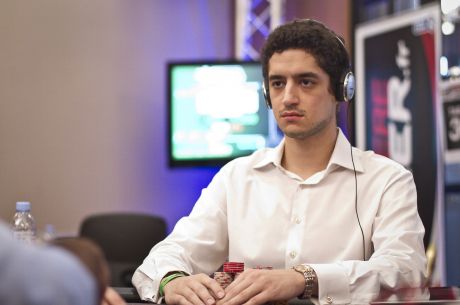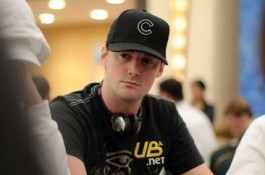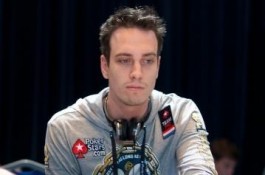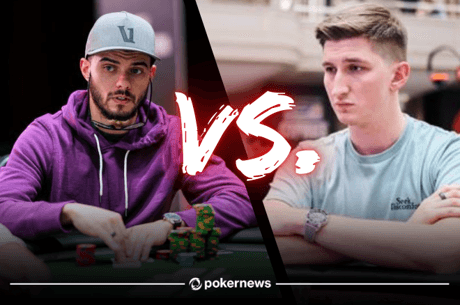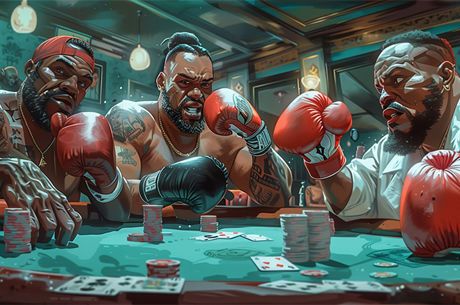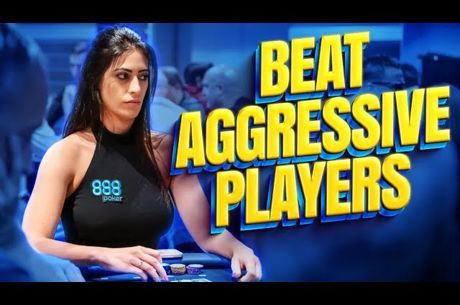Representing Hands with Shaun Deeb

Shaun Deeb is known for his incredible tournament results, as well as his ability to articulate strategy. He recently made the trip to Monaco for the European Poker Tour Grand Final Main Event and also competed in a couple of the side tournaments as well. He talked to PokerNews about an interesting hand he played that highlights this week’s concept: Representing hands.
Tournament: €5,000 buy-in six-max
Blinds: 100-200 with a 25 ante
Hand
At the time, I had 70,000 with the average at 30,000, so I had a lot of chips at that point in the tournament. I was opening a decent number of pots, and in this hand, I opened to 525 with queen-jack off in the hijack. The guy to my left with about 30,000 flatted, the button flatted, the small blind flatted, and the big blind flatted.
The flop comes king-ten-seven rainbow. The small blind led for 1,550 with about 25,000 behind. The big blind folded, and I flatted. I could have done anything on a rainbow board. I definitely consider raising versus a lot of opponents. The button pretty quickly made it 3,500, which is pretty strong sizing considering our stack sizes and the board texture. The small blind tanked and then flatted. At this point, I know I’m calling, but I think about it to make it seem like I don’t have the hand I have. Considering how deep we are and that I’m drawing to the nuts, if I three-bet there, it looks strong, but I think that if a guy hand king-ten or a set of sevens or anything strong, they wouldn’t fold to my three-bet. The only hand I’d get to fold is a one-pair hand, and there aren’t many draws. If I three-bet, I get four-bet by the hands that I want to have in the pot in case I hit to pay me off.
The turn came a jack, bringing a backdoor flush-draw and then a very interesting thing happened. The small blind decided to lead 3,200 into a pot that was about 12,500 or 13,000, leaving himself with 15,000 behind. Now I know the button has what I would consider a very strong hand. I’m thinking of ways of getting the small blind to fold and getting heads up with the button, and/or over-rep my hand and get kings-up to fold. I end up making it 10,600. The button tanked for about a minute-and-a-half. He’s in a miserable spot. I could have ace-queen, queen-nine, or eight-nine. I have all the straights in my range, and he almost never has a straight in his range.
If the river was a brick, I was planning on shoving since I’d set up a pot-size river-shove if I got called. The button called. Then the small blind goes into the tank himself, and he’s feeling pretty terrible. I’m thinking that he’s going to fold eight-nine because he’s thinking that the button has a set and I probably have ace-queen. He folds and the river comes an offsuit ace. I know the button never has a queen in his range, but I’m not sure if he knows I know that. I normally go for a value bet here, but since this hand is so obscure, I thought he might decide to hero call with a set if I shove for about 40,000, which was slightly more than pot. He thought about it for awhile before folding. I showed the jack, and the whole table went crazy. The small blind was so pissed off because he folded the best hand by far on the turn.
What was your table image before this hand?
My table image is usually pretty aggressive. I get recognized a lot at the table, so I think three or four of the players knew who I was online. Since I came to the table with 60,000, with the starting stack being 15,000, they probably figured I was pretty active.
Let’s back up. Can you talk me through what was going through your head on the flop and turn?
On the flop, I basically said to myself, I have eight clean outs to the nuts. It’s very rare that one of the other opponents has queen-jack the way the betting went. It’s very unlikely the button is going to raise with that draw, and it’s very unlikely the small blind is going to lead with that draw. Since that’s the way the hand went down, I was confident that my outs were clean. I also thought I’d get paid off. Since the sizing was so small on the flop, I could rep any gutshot if a queen or jack came on the turn, and I could possibly win the pot. And if a king or a ten came, I could possibly bluff too. I had really good position and a good stack size to maneuver and bluff a much better hand. If someone had ace-king, there are a number of combinations in the making where I could get him to fold. No matter what came, I could rep it. If a ten came, I could rep trips and act like I had ace-ten and called the flop and was getting priced in because the flop raise was so small, that I’d peel.
This hand was all about what you could credibly represent, is that right?
Yeah, basically when it comes to the turn, I am the most likely person to have ace-queen. I was the preflop raiser, I was calling, calling. I was deep enough and getting the right price along the way. When the small blind leads on the flop, I can be floating with a gutshot and overcard, or be thinking that I had the best hand. The way the hand went down, I was just very confident that no matter what was going on, I was going to convince them by the river that I had a gutshot and hit it on the turn. That was my goal. We were 300 big blinds deep so for people to call with the fifth or sixth nuts which a set would be on the board is really, really tough. So even if the river blanked, I was planning on shoving. I don’t know if he would have folded or not, but it might have worked. If it didn’t, it didn’t, but I think it would have put him in a really tough spot.
So even if it was a blank on the river and he tank-called, you would have felt good about the play?
Yeah, I clearly realized that he would think it was believable that I had ace-queen. [laughs] But if he insta-called the river, then I would have felt bad.
What are the most important aspects to keep in mind when you are making a play like this, and you’re trying representing a hand?
Basically, when you’re repping, you have to do it against competent, thinking opponents who will put you on a range, whether you’re bluffing or value-betting, and interpret what they think your bets mean. When I raised the turn in this hand, they are going to interpret that like I had improved my hand in some way. I could have picked up a pair, a set, a flush draw, or a straight. There were a lot of different hands I could have. That’s what I was going for. All the hands that improved on the turn were in my range, but not theirs because they represented a lot of strength on that flop, and no hands that rep a lot of strength on that flop really like the turn card, unless they have eight-nine, but the eight-nine is still the third nuts. That’s the beauty of this hand is that they never have the nuts in this hand. In this spot, even though they may have relatively strong hands, according to the line I took, they were only bluff catchers.
What mistakes do you see beginners making when trying to represent hands?
You have to realize, and a lot of old pros say this, but when you make a bluff, you have to make the story believable. That’s how simple it is. If someone has seen you bet a flush draw every time, but in a certain hand you call and then raise the river when the flush comes, it’s not going to make sense. Based on the way my hand went down, the positions and preflop ranges and the way they adjusted as the hand progressed, I knew that the turn card was a good one to bluff. It’s all about board texture and understanding how hand ranges change with every card that comes off.
Follow us on Twitter for up-to-the-minute news.

